The Paediatric Wheelchairs Market is estimated to be valued at USD 2.6 billion in 2025 and is projected to reach USD 5.1 billion by 2035, registering a compound annual growth rate (CAGR) of 7.0% over the forecast period.
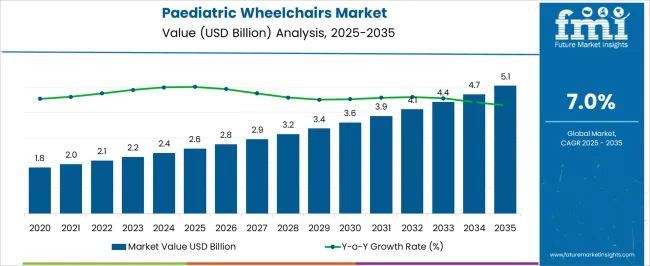
| Metric | Value |
|---|---|
| Paediatric Wheelchairs Market Estimated Value in (2025 E) | USD 2.6 billion |
| Paediatric Wheelchairs Market Forecast Value in (2035 F) | USD 5.1 billion |
| Forecast CAGR (2025 to 2035) | 7.0% |
The paediatric wheelchairs market is experiencing strong growth driven by increasing awareness of mobility solutions for children with physical disabilities and chronic conditions. Rising investment in pediatric healthcare infrastructure and supportive government policies for child accessibility are fueling market expansion. Advances in lightweight materials, ergonomic design, and modular construction have improved the functionality and comfort of wheelchairs for children, enhancing user experience and caregiver convenience.
Growing adoption of assistive mobility devices in homecare, rehabilitation, and educational environments is also contributing to demand. The integration of foldable, adjustable, and customizable features into pediatric wheelchairs allows for better portability and adaptability across different settings.
As the prevalence of childhood disabilities and mobility impairments rises globally, demand for high-quality and durable pediatric wheelchairs is expected to increase Market growth is further supported by increased collaboration between healthcare providers, manufacturers, and caregivers to provide safe and efficient mobility solutions tailored for children, creating significant opportunities for innovation and long-term market expansion.
The paediatric wheelchairs market is segmented by product, frame, application, and geographic regions. By product, paediatric wheelchairs market is divided into Manual and Electric. In terms of frame, paediatric wheelchairs market is classified into Foldable Wheelchairs and Rigid Wheelchairs. Based on application, paediatric wheelchairs market is segmented into Homecare, Hospitals, and Others. Regionally, the paediatric wheelchairs industry is classified into North America, Latin America, Western Europe, Eastern Europe, Balkan & Baltic Countries, Russia & Belarus, Central Asia, East Asia, South Asia & Pacific, and the Middle East & Africa.
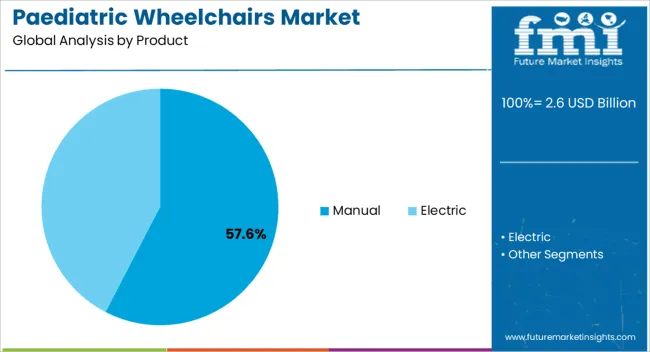
The manual segment is projected to hold 57.6% of the paediatric wheelchairs market revenue share in 2025, establishing it as the leading product type. Its dominance is being supported by affordability, ease of use, and reduced maintenance requirements compared to powered alternatives. Manual wheelchairs allow for greater independence in homecare and educational environments, with caregivers and children able to adjust propulsion as needed.
Lightweight materials and ergonomic designs improve comfort and maneuverability, making manual wheelchairs suitable for both indoor and outdoor use. The segment benefits from widespread availability and lower production costs, which enhances accessibility for families and healthcare providers globally.
Growing focus on homecare applications, where compact, reliable, and easy-to-handle devices are essential, further reinforces the popularity of manual wheelchairs As manufacturers continue to innovate in foldable frames and modular components, the manual segment is expected to maintain its leading position, driven by high demand for cost-effective, durable, and versatile pediatric mobility solutions.
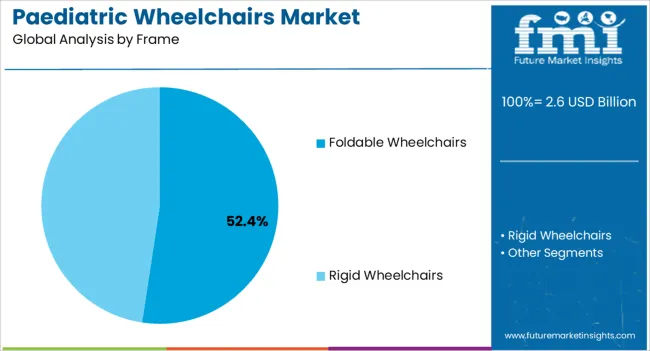
The foldable wheelchairs segment is anticipated to account for 52.4% of the market revenue share in 2025, making it the dominant frame type. This leadership is being driven by the convenience of portability and storage, which is highly valued in homecare and transport applications. Foldable wheelchairs allow caregivers and children to easily transfer the device in vehicles, store it in compact spaces, and adjust configurations as needed, improving daily usability.
The segment benefits from increasing adoption in urban environments where space efficiency and mobility flexibility are critical. Technological improvements in folding mechanisms, durability, and lightweight construction are further enhancing performance and reliability.
Growing awareness among healthcare providers and parents about ergonomic and adaptable mobility solutions is contributing to rising demand The segment’s ability to combine convenience, safety, and structural strength ensures its continued preference, positioning foldable wheelchairs as a key driver of market growth in pediatric mobility solutions.
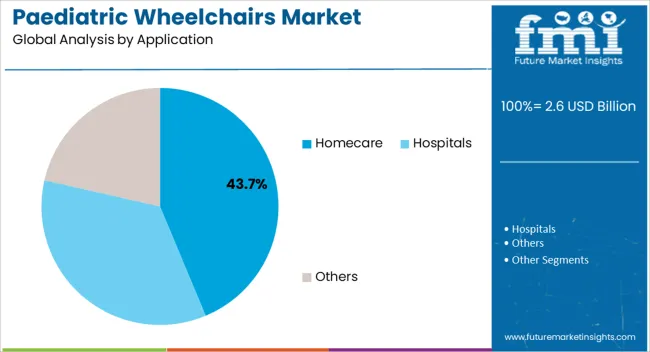
The homecare application segment is expected to hold 43.7% of the paediatric wheelchairs market revenue share in 2025, establishing it as the leading end-use application. This dominance is being driven by the increasing need for child-friendly mobility solutions in domestic settings, where safe and ergonomic devices are essential for daily living.
Paediatric wheelchairs in homecare applications support independence, improve quality of life, and reduce caregiver strain. Rising awareness about childhood mobility impairments and the importance of early intervention is increasing adoption in residential environments.
The segment is further supported by customization options, including adjustable seating, foldable frames, and lightweight materials, which allow children and caregivers to tailor the device to individual needs As healthcare policies and social support programs prioritize accessible homecare solutions, the segment is expected to continue leading the market, supported by innovation in design and usability that enhances convenience, safety, and long-term functionality for pediatric users.
An increase in the disabilities experienced by children is expected to surge the demand for paediatric wheelchairs during the forecast period.
Furthermore, this mobility equipment is designed in such a manner that it can readjust as per the child's growth. Besides this, the parents of such children are firm in the view that such disabilities should not stop their children's progress. Therefore, the adoption of paediatric wheelchairs by such children would make the children independent as well.
While there are a variety of products serving the needs of adult disability patients who need mobility support, there is also a niche market for paediatric wheelchairs that serve all the needs of the children who need assistance in mobility. The wheelchairs for children need to be different from the ones that are designed for adults since children have altogether different needs.
As children are constantly growing, the main feature that paediatric wheelchairs have is their adaptability. All the parts of a paediatric wheelchair are designed in such a manner that they can be adjusted as per the growth of the child and easily take more weight as time passes.
Since the paediatric wheelchairs market is an established market with a huge scope of growth, and due to supportive government policies and funding across the world, manufacturers are coming up with new models and features that make paediatric wheelchairs easy to use, lighter in weight and more adaptable to the needs of children using them.
Paediatric wheelchairs market is also growing since there is a rise in disposable income and parents want their mobility challenged children to be as independent as possible and to live a life of dignity.
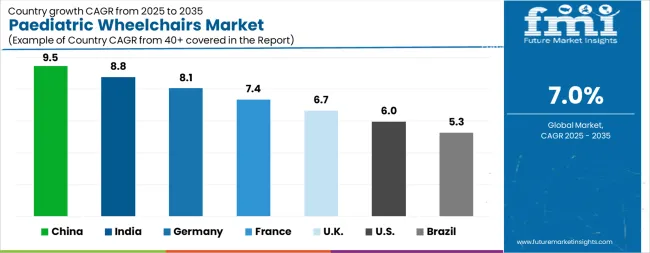
| Country | CAGR |
|---|---|
| China | 9.5% |
| India | 8.8% |
| Germany | 8.1% |
| France | 7.4% |
| UK | 6.7% |
| USA | 6.0% |
| Brazil | 5.3% |
The Paediatric Wheelchairs Market is expected to register a CAGR of 7.0% during the forecast period, exhibiting varied country level momentum. China leads with the highest CAGR of 9.5%, followed by India at 8.8%. Developed markets such as Germany, France, and the UK continue to expand steadily, while the USA is likely to grow at consistent rates. Brazil posts the lowest CAGR at 5.3%, yet still underscores a broadly positive trajectory for the global Paediatric Wheelchairs Market. In 2024, Germany held a dominant revenue in the Western Europe market and is expected to grow with a CAGR of 8.1%. The USA Paediatric Wheelchairs Market is estimated to be valued at USD 976.6 million in 2025 and is anticipated to reach a valuation of USD 1.7 billion by 2035. Sales are projected to rise at a CAGR of 6.0% over the forecast period between 2025 and 2035. While Japan and South Korea markets are estimated to be valued at USD 120.9 million and USD 74.5 million respectively in 2025.

| Item | Value |
|---|---|
| Quantitative Units | USD 2.6 Billion |
| Product | Manual and Electric |
| Frame | Foldable Wheelchairs and Rigid Wheelchairs |
| Application | Homecare, Hospitals, and Others |
| Regions Covered | North America, Europe, Asia-Pacific, Latin America, Middle East & Africa |
| Country Covered | United States, Canada, Germany, France, United Kingdom, China, Japan, India, Brazil, South Africa |
| Key Companies Profiled | MEYRA GmbH, Sunrise Medical, SORG Rollstuhltechnik GmbH, Invacare, Momentum Healthcare, Permobil, AKCES-MED sp.z., Medline, Drive Medical, Numotion, Carex Health, and Pride Mobility |
The global paediatric wheelchairs market is estimated to be valued at USD 2.6 billion in 2025.
The market size for the paediatric wheelchairs market is projected to reach USD 5.1 billion by 2035.
The paediatric wheelchairs market is expected to grow at a 7.0% CAGR between 2025 and 2035.
The key product types in paediatric wheelchairs market are manual and electric.
In terms of frame, foldable wheelchairs segment to command 52.4% share in the paediatric wheelchairs market in 2025.






Our Research Products

The "Full Research Suite" delivers actionable market intel, deep dives on markets or technologies, so clients act faster, cut risk, and unlock growth.

The Leaderboard benchmarks and ranks top vendors, classifying them as Established Leaders, Leading Challengers, or Disruptors & Challengers.

Locates where complements amplify value and substitutes erode it, forecasting net impact by horizon

We deliver granular, decision-grade intel: market sizing, 5-year forecasts, pricing, adoption, usage, revenue, and operational KPIs—plus competitor tracking, regulation, and value chains—across 60 countries broadly.

Spot the shifts before they hit your P&L. We track inflection points, adoption curves, pricing moves, and ecosystem plays to show where demand is heading, why it is changing, and what to do next across high-growth markets and disruptive tech

Real-time reads of user behavior. We track shifting priorities, perceptions of today’s and next-gen services, and provider experience, then pace how fast tech moves from trial to adoption, blending buyer, consumer, and channel inputs with social signals (#WhySwitch, #UX).

Partner with our analyst team to build a custom report designed around your business priorities. From analysing market trends to assessing competitors or crafting bespoke datasets, we tailor insights to your needs.
Supplier Intelligence
Discovery & Profiling
Capacity & Footprint
Performance & Risk
Compliance & Governance
Commercial Readiness
Who Supplies Whom
Scorecards & Shortlists
Playbooks & Docs
Category Intelligence
Definition & Scope
Demand & Use Cases
Cost Drivers
Market Structure
Supply Chain Map
Trade & Policy
Operating Norms
Deliverables
Buyer Intelligence
Account Basics
Spend & Scope
Procurement Model
Vendor Requirements
Terms & Policies
Entry Strategy
Pain Points & Triggers
Outputs
Pricing Analysis
Benchmarks
Trends
Should-Cost
Indexation
Landed Cost
Commercial Terms
Deliverables
Brand Analysis
Positioning & Value Prop
Share & Presence
Customer Evidence
Go-to-Market
Digital & Reputation
Compliance & Trust
KPIs & Gaps
Outputs
Full Research Suite comprises of:
Market outlook & trends analysis
Interviews & case studies
Strategic recommendations
Vendor profiles & capabilities analysis
5-year forecasts
8 regions and 60+ country-level data splits
Market segment data splits
12 months of continuous data updates
DELIVERED AS:
PDF EXCEL ONLINE
Paediatric Oncology Therapeutics Market Size and Share Forecast Outlook 2025 to 2035
Paediatric Vaccine Market Size and Share Forecast Outlook 2025 to 2035
Paediatric Sports Medicine Market Size and Share Forecast Outlook 2025 to 2035
Paediatric Spasticity Treatment Market Size and Share Forecast Outlook 2025 to 2035
Paediatric influenza treatment market Size and Share Forecast Outlook 2025 to 2035
Paediatric & Neonatal Testing Kits Market – Growth & Forecast 2025 to 2035
Paediatric Respiratory Syncytial Virus Infection Market Growth - Trends & Forecast 2025 to 2035
Paediatric Neuropsychiatric Disorders Treatment Market
Paediatric Respiratory Disease Therapeutics Market
Bariatric Transport Wheelchairs Market Size and Share Forecast Outlook 2025 to 2035

Thank you!
You will receive an email from our Business Development Manager. Please be sure to check your SPAM/JUNK folder too.
Chat With
MaRIA